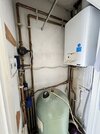Hi all, asking for some advice after reading around a bit please
My parents have a 5 bedroom (2900 sq ft) house with 3 bathrooms. The boiler is in the original part of the house (so it is situated on one side of the house). We found several problems with the system over the years. They built a significant extension years ago and the radiators there don't heat up very well (maybe narrow pipes or not powerful enough system/pump/flow). There is very low flow (cold water 3L/min and hot 7L/min) of water in the house. I think they have called the water suppliers to try to increase this, but I also suspect that the old piping system is narrow gauge (not sure exactly what diameter). The other issue is that the immersion heater is broken and the only way to access hot water is to switch on central heating (which I don't really understand).
The heating system is an old >15 year old British Gas 330 boiler with a 140 L tank + 2.8kw immersion heater. There is a water tank in the loft.
We installed a water pump for one of the toilets and it whirrs away when hot water tap is switched on
There is another pump (not sure when it was installed) - Grundfos ups3 15-50/65 130 - in the boiler cupboard
There seems to be a huge complexity of pipes (as seen in the photo)
I'm looking to simplify the system and wondering if a combi boiler is the way to go. We don't use more than 2 hot water sources at a time. I understand that the central heating will be fine with even a reasonably low Kw rating and that hot water on-demand is the key factor to consider. After reading around, it seems like my pumps are inadequate and my water flow is too low to begin with.
With this background, is there even a point in 'upgrading' to a combi boiler with a higher Kw/flow rating (£3.5-4.5k)?
It feels outdated to have a water tank/immersion heater/ insulated tank setup, but I'm no professional!
Thanks for any advice everyone!

My parents have a 5 bedroom (2900 sq ft) house with 3 bathrooms. The boiler is in the original part of the house (so it is situated on one side of the house). We found several problems with the system over the years. They built a significant extension years ago and the radiators there don't heat up very well (maybe narrow pipes or not powerful enough system/pump/flow). There is very low flow (cold water 3L/min and hot 7L/min) of water in the house. I think they have called the water suppliers to try to increase this, but I also suspect that the old piping system is narrow gauge (not sure exactly what diameter). The other issue is that the immersion heater is broken and the only way to access hot water is to switch on central heating (which I don't really understand).
The heating system is an old >15 year old British Gas 330 boiler with a 140 L tank + 2.8kw immersion heater. There is a water tank in the loft.
We installed a water pump for one of the toilets and it whirrs away when hot water tap is switched on
There is another pump (not sure when it was installed) - Grundfos ups3 15-50/65 130 - in the boiler cupboard
There seems to be a huge complexity of pipes (as seen in the photo)
I'm looking to simplify the system and wondering if a combi boiler is the way to go. We don't use more than 2 hot water sources at a time. I understand that the central heating will be fine with even a reasonably low Kw rating and that hot water on-demand is the key factor to consider. After reading around, it seems like my pumps are inadequate and my water flow is too low to begin with.
With this background, is there even a point in 'upgrading' to a combi boiler with a higher Kw/flow rating (£3.5-4.5k)?
It feels outdated to have a water tank/immersion heater/ insulated tank setup, but I'm no professional!
Thanks for any advice everyone!


